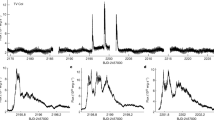Abstract
Many (∼50) cataclysmic variables, binary systems in which a white dwarf accretes from a close companion star, are now known to be hard (≳2 keV) and variable X-ray sources1. While some of these ∼15) exhibit regular pulsing in X rays, suggesting that they have magnetic fields strong enough to channel the accretion flow onto restricted parts of the white dwarf surface (the AM Her and ‘intermediate polar’ systems), the majority do not, and hence presumably have rather weaker fields (B≲105 G). SS Cygni, the brightest object of this ‘non-magnetic’ class, exhibits a combination of systematic features in its X-ray and optical emission which existing models are only partially successful in reproducing. We suggest here that at sufficiently low accretion rates a thermal instability in the accretion flow leads to the formation of a hard X-ray-emitting corona around the white dwarf; the corona is relatively suppressed at higher accretion rates. We show that the cooling of such a corona gives the observed correlation between X-ray temperature and luminosity, and that hard X-ray production may be rather inefficient because of transport processes. These can give rise to soft X-ray emission from most of the white dwarf surface, with a correspondingly low effective temperature.
This is a preview of subscription content, access via your institution
Access options
Subscribe to this journal
Receive 51 print issues and online access
$199.00 per year
only $3.90 per issue
Buy this article
- Purchase on Springer Link
- Instant access to full article PDF
Prices may be subject to local taxes which are calculated during checkout
Similar content being viewed by others
References
Córdova, F. A. & Mason, K. O. in Accretion Driven Stellar X-ray Sources (eds Lewin, W. H. G. & van den Heuvel, E. P. J.) Ch. 4 (Cambridge University Press, 1983).
Ricketts, M. J., King, A. R. & Raine, D. J. Mon. Not. R. astr. Soc. 186, 233 (1979).
Swank, J. H. IAU Colloq. 53, 135 (1979).
Pringle, J. E. & Savonije, G. J. Mon. Not. R. astr. Soc. 187, 777 (1979).
Tylenda, R. Acta astr. 31, 127 (1981).
Pringle, J. E. A. Rev. Astr. Astrophys. 19, 137 (1981).
Buff, J. & McCray, R. Astrophys. J. 189, 147 (1974).
Pallavincini, R. et al. Astrophys. J. 270, 270 (1983).
Frank, J., King, A. R. & Lasota, J. P. Mon. Not. R. astr. Soc. 202, 183 (1983).
King, A. R. IAU Colloq. 72, 181 (1983).
Frank, J. & King, A. R. Astr. Astrophys. (in the press).
Author information
Authors and Affiliations
Rights and permissions
About this article
Cite this article
King, A., Shaviv, G. X-ray emission from non-magnetic cataclysmic variables. Nature 308, 519–521 (1984). https://doi.org/10.1038/308519a0
Received:
Accepted:
Issue Date:
DOI: https://doi.org/10.1038/308519a0
This article is cited by
-
Observations and theory of cataclysmic variables: On progress and problems in understanding dwarf novae and nova-like stars
Space Science Reviews (1994)
-
Local thermonuclear runaways among classical novae
Astrophysics and Space Science (1993)
Comments
By submitting a comment you agree to abide by our Terms and Community Guidelines. If you find something abusive or that does not comply with our terms or guidelines please flag it as inappropriate.



